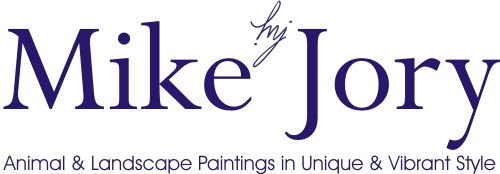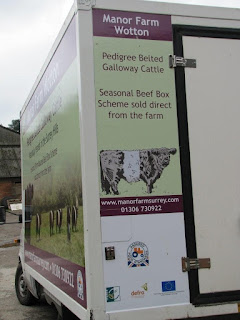I'm currently continuing the theme I started with 'This Way To The Beach' (below)
and 'Going To Town' (below)
As you may have noticed from the pictures above, that theme is belted galloway cows in unexpected places! I'm really enjoying placing these visually arresting animals in unusual environments and thereby creating unusual interactions. For example, in 'Going To Town' the pedestrians seem oblivious to the bovine visitor. However, in my current painting (still in progress, see below) the group of people are aware of the three belties that are stood in front of the cathedral. I've always enjoyed painting people but being able to combine animals and people in one picture is proving to be a real treat :-) Here's the painting so far...
Friday 18 November 2016
Thursday 17 November 2016
Horse Painting video demonstration part 3 - bringing backgrounds to the fore
Here's part 3 of the acrylic painting of a wild Dartmoor horse. This one
is pretty simple as I'm just applying some background colour but here
are a few tips that you may wish to consider when doing your own
paintings:
1) Keeping your paint thin and runny
and applying it with brushstrokes in a range of directions will add
interesting texture to an area that could otherwise be just a block of
colour.
2) Repeating the above with a different colour can provide nice layered colour effects.
3)
With the example in the video, I enhance the contrast of the image by
making the background darker in places next those parts of the horse
that are bathed in light. Similarly, I place light background areas next
to regions of the horse that's in shadow.
4)
Working fast and applying the paint without too much thought can
sometimes prove advantageous and create effects you wouldn't otherwise
come across.
5) Conversely, it's also worth
thinking about the direction of background brushstrokes and how they can
complement your subject e.g. generally, one thing to avoid is having
your background brushstroke follow the entire outline of your subject.
6)
If using thin paint, don't be too afraid of going over the edge of your
subject in places as this will often produce a nice soft edge.
Hope this was helpful, if you'd like to see the finished painting 'Roaming Free' it can be found here. If you have any questions, please feel free to get in touch.
Art by Mike Jory: website facebook twitter
Tuesday 15 November 2016
Acrylic Painting Techniques - 5 Reasons to be Proactive with Atelier Interactive
Atelier Interactive acrylics open up new creative avenues for artists to explore. Conventional acrylic paints, once dry, are totally waterproof. Atelier interactive acrylics are different in that, even when touch-dry, the paint can be reactivated by spraying the painting surface with water. Here are some of the benefits that I've found over the last few years of using them.
1) Blend at your leisure, for painting pleasure.
Blending colours and tones is really easy with these paints. A technique that works well for me is to apply a block of colour and then lightly spray the area with water. Next, a second colour is applied very gently through this area of wet paint. Check out some examples below:
In the detail of 'A Lunch Interrupted' above, you can see I've blended cerulean blue and purple with a very dark blue on the side of this black Angus cow. The image below is a detail from "Come On, Keep Up" and I've used a similar technique with this calf painting, particularly on the hind quarters.
2) Terrific textures
Using a similar technique to above but being a bit firmer with the second layer of paint you can create really interesting textures and I sometimes use these for the fur, wool or hair on animals. Check out this example below, a detail of 'It's Sunny Here', where I've used this wet-in-wet technique to introduce some texture over the bridge of this sheep's nose and below the eye on the right side of the painting.
3) Heavenly hatching
Cross-hatching is the use of a pattern of criss cross fine lines to shade an area of a picture. This is most commonly done with drawings where you can use a pencil or pen to create the pattern one line at a time. However, it can also be done with a brush and I find spraying water onto interactive acrylic still on the palette to create really fluid paint and then applying this with a large frayed brush can create some really nice effects. The technique has been used on the side of these belted galloway cows shown below (you can see the full painting 'Hidden By Stone Walls' here).
4) Made a mistake or two? Now you have a Ctrl-Z undo!
You know when you're using a Windows program and you suddenly realize you've accidentally deleted something or made a mistake...just press Ctrl-Z and all is good right? Well now you can do the same thing with your painting. With normal acrylic, once the paint is dry your only choice is to paint over the error. With interactive acrylic, you can simply spray the dry paint with water then take a damp paper towel to remove the mistake. This is something I do in the video below.
5) Paint interactive acrylic on top of conventional acrylic
If you do your under painting with conventional acrylic then, once dry, you now have a wonderfully smooth surface upon which to apply interactive acrylic. This is a technique I've used many times and I really love the way the interactive paint slides over the dried conventional acrylic paint. Here's an example where I used this technique. (You can see the full version of 'Strike A Pose' here).
Hope you find this info useful, feel free to drop me a line if you have any questions.
1) Blend at your leisure, for painting pleasure.
Blending colours and tones is really easy with these paints. A technique that works well for me is to apply a block of colour and then lightly spray the area with water. Next, a second colour is applied very gently through this area of wet paint. Check out some examples below:
In the detail of 'A Lunch Interrupted' above, you can see I've blended cerulean blue and purple with a very dark blue on the side of this black Angus cow. The image below is a detail from "Come On, Keep Up" and I've used a similar technique with this calf painting, particularly on the hind quarters.
2) Terrific textures
Using a similar technique to above but being a bit firmer with the second layer of paint you can create really interesting textures and I sometimes use these for the fur, wool or hair on animals. Check out this example below, a detail of 'It's Sunny Here', where I've used this wet-in-wet technique to introduce some texture over the bridge of this sheep's nose and below the eye on the right side of the painting.
3) Heavenly hatching
Cross-hatching is the use of a pattern of criss cross fine lines to shade an area of a picture. This is most commonly done with drawings where you can use a pencil or pen to create the pattern one line at a time. However, it can also be done with a brush and I find spraying water onto interactive acrylic still on the palette to create really fluid paint and then applying this with a large frayed brush can create some really nice effects. The technique has been used on the side of these belted galloway cows shown below (you can see the full painting 'Hidden By Stone Walls' here).
4) Made a mistake or two? Now you have a Ctrl-Z undo!
You know when you're using a Windows program and you suddenly realize you've accidentally deleted something or made a mistake...just press Ctrl-Z and all is good right? Well now you can do the same thing with your painting. With normal acrylic, once the paint is dry your only choice is to paint over the error. With interactive acrylic, you can simply spray the dry paint with water then take a damp paper towel to remove the mistake. This is something I do in the video below.
5) Paint interactive acrylic on top of conventional acrylic
If you do your under painting with conventional acrylic then, once dry, you now have a wonderfully smooth surface upon which to apply interactive acrylic. This is a technique I've used many times and I really love the way the interactive paint slides over the dried conventional acrylic paint. Here's an example where I used this technique. (You can see the full version of 'Strike A Pose' here).
Hope you find this info useful, feel free to drop me a line if you have any questions.
Monday 14 November 2016
Belted Galloway Cows logo and painting
This was a really cool project I worked on with Paula Matthews from Manor Farm in Surrey. Paula provided me with a range of photos of her herd of belted galloway cattle. I created a black and white logo of a belted galloway cow (based on one of the farm's cows) and Paula then had it printed onto bags, banners and a van. As the preparatory work for a logo and a painting are essentially the same, Paula also commissioned a painting of some belties in the Surrey countryside which is now on display in the farm shop. Check out the photos below and you can see more belted galloway cow art here.
Labels:
art,
belted galloway cows,
belties,
logo,
paintings
Sunday 13 November 2016
Dodging traffic in Devon - Painting of the River Exe
Following on from the series of horse painting videos, here I take a totally different approach and talk about some of the things that usually go on behind the scenes when creating a painting. Here, this includes taking reference photos, doing some thumbnail sketches and some experimental paintings before completing the final picture. The finished painting "Along The River Exe" depicts my version of the view from Cowley Bridge which is on the edge of the city of Exeter
Subscribe to:
Posts (Atom)
















